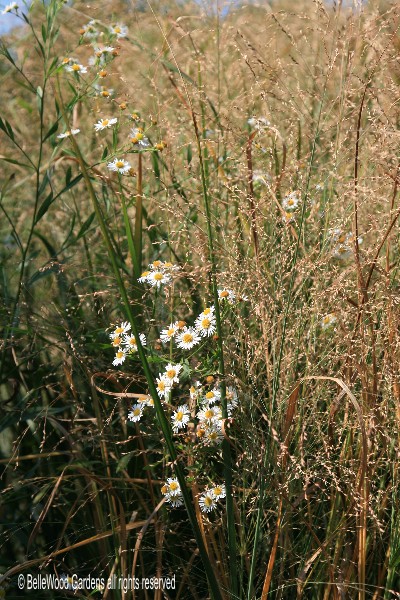
.
If you have any comments, observations, or questions about what you read here, remember you can always Contact Me
All content included on this site such as text, graphics and images is protected by U.S and international copyright law.
The compilation of all content on this site is the exclusive property of the site copyright holder.
Ask someone where a plant came from, and they are likely to tell you the name of the garden center at which it was purchased. Plants grow where they can. Some were here before the European settlers came. They're native. City dwellers might think of dandelions as "native" flowers. They, and others, came with the colonists - deliberate introductions such as dandelion and clover, others accidental arrivals in animal fodder and bedding. Some happily made themselves at home without a visa or green card. Look at a roadside in summer, admiring the tawny daylily, froth of Queen Anne's lace, sky blue chickory - all growing without a gardener's attentive care. These naturalized plants weave themselves into the tapestry of our landscapes, perhaps too well in the case of garlic mustard and multiflora rose. Then there are exotics such as hellebores and Japanese painted fern, able to grow quite well in local habitats but in need of some human assistance.
Plants are the material and design, a garden's style, the method. While the plants certainly have influence, they do not necessarily dictate the style. Consider liatris. Native to the grasslands of the MIdwest, they're suitable to a native meadow or prairie garden, might be included in a casual cottage garden or more formal herbaceous border, belong in a cutting garden, and their seeds are relished by goldfinches suggesting placement in a wildlife garden. True, some are more . . . . shall we say gardenesque? Those with double flowers or variegated foliage suggest cultivation more than do single flowers and green leaves.
The site itself dictates certain constraints on a garden's style and composition. Take grasslands. Are we thinking of the vast steppes of central Asia, African veldt, expansive prairie, attractive meadow . . . . or the restricted scale of a lawn in the city. A grassland is, by its very nature, composed primarily of grasses with an admixture of flowering plants.

In a garden, even a "meadow" garden, human nature selects a majority of showy colorful flowers and a minority of grasses. Fire is a component of grassland success. It rejuvenates the site with suppression of woody plants and recycling nutrients. How do you explain to neighbors that you just happened to drop the stub of a cigarette each fall, burning the withered grasses and forbs of a handkerchief-size backyard meadow?
It is so difficult to find a natural site to observe and explore. Grasslands may still be growing grasses, but today they're a hay field, crop fields of corn or wheat, a turf grass lawn.
Longwood Gardens has created a magnificent 86 acre meadow, doubling the size of the original and adding trails,bridges, benches, several information pavillions, and plants, tens of thousands of plants. I was fortunate to be there on a drizzle-y preview. Some facts and figures we were provided about the project: the Meadow Garden was under construction for 10 months. There are 3 miles of trails. In addition to the hundreds of plant varieties already thriving in the Meadow and the surrounding woodland edge, hundred and ten new or additional plant species were added among 100,000 native wildflower and grass landscape plugs that were planted to create sweeps of color, texture, and biodiversity that permeate the landscape, providing interest and habitat benefit in every season. As well, 1,100 native trees and shrubs were planted. Now, in spring, such popular woody plants such as Carolina silverbell, Halesia monticola; Eastern redbud, Cercis canadensis; flowering dogwood , Cornus florida; and sweet azalea, Rhododendron arborescens embellish the ecotone where woodland and meadow meet. As an aside, these small native trees and shrubs are popular landscape plants. Natives are available in garden centers. Remember, plants are the material from which a garden is created. The plants do not make the design. And on the forest floor, beneath these trees, a layer of herbaceous species such as wild cranesbill, Geranium maculatum; Indian-physic or bowman's root, Gillenia trifoliataand Virginia bluebells, Mertensia virginiana add to the display.
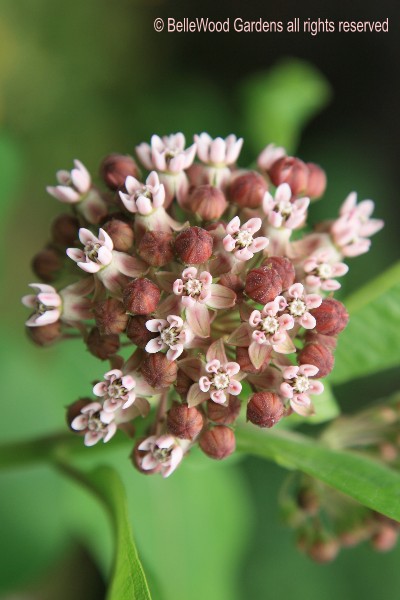
In summer, meadow species such as black-eyed Susan, hollow Joe-Pye-weed and various sunflowers and ironweeds will provide visual show and habitat benefit, along with host plants for the declining monarch butterfly such as common milkweed, Asclepias syriaca above, and the related butterfly-weed, and swamp milkweed.
These are plants that we appreciate somewhat in the abstract, aesthetically, for their beauty in flower. They are important in the web of life, appreciated from necessity by pollinators. Hollow Joe-Pye-weed, Eutrochium fistulosum, provides nectar for butterflies, including the Eastern swallowtail, while white turtle-head Chelone glabra is a host plant for the Baltimore checkerspot butterfly. Common milkweed, Asclepias syriaca and the bright orange butterfly-weed, Asclepias tuberosa, are two important host plants for the threatened monarch butterfly caterpillar. The deep red of cardinal-flower, Lobelia cardinalis, is a favorite of ruby-throated hummingbirds, while wild bergamot, Monarda fistulosa, and penstemon Penstemon digitalis, are favored by bumblebees.
The fall palette includes a diversity of native asters: Symphyotrichum (Aster) cordifolium, Eurybia (Aster) divaricata 'Eastern Star', Symphyotrichum ericoides 'Snow Flurry', S. laevis 'Bluebird', S. lateriflorum 'Lady in Black', S. novi-belgii, S. oblongifolium 'October Skies'. A thorough sampling of other Compositae: Boltonia steroides; prairie coneflower, Echinacea purpurea; hollow Joe-Pye-weed, Eutrochium (Eupatorium) fistulosum; a couple of yellow sunflowery daisies, Helianthus divaricatus and Heliopsis helianthoides; a trio of gayfeather, Liatris microcephala, L. spicata, L. squarrosa; orange coneflower, Rudbeckia fulgida; cut-leaved sunflower, R. laciniata; R. triloba; and a couple of ironweed, Vernonia glauca, and V. noveboracensis.
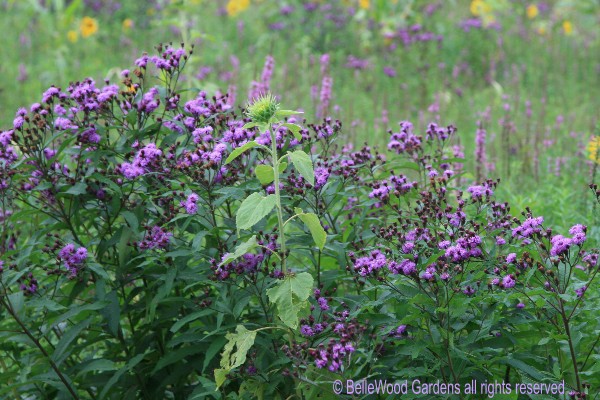
Ironweed, Vernonia sp., happily growing in a wet meadow.
Non-daisy flowered natives include rattlebush, Baptisia australis; white turtlehead, Chelone glabra; ratlesnake master, Eryngium yuccafolium; horsemint or wild bergamot, Monarda fistulosa; penstemon, Penstemon digitalis; American mountain mint, Pycnanthemum flexuosum and P. tenuifolium; bowman's root, Veronicastrum virginicum; and golden Alexanders, Zizia aurea. As well, warm-season meadow grasses along with the foliage of woodland edge species such as red and sugar maple, and red, white and mossy-cup oaks will add color and beauty to the landscape.
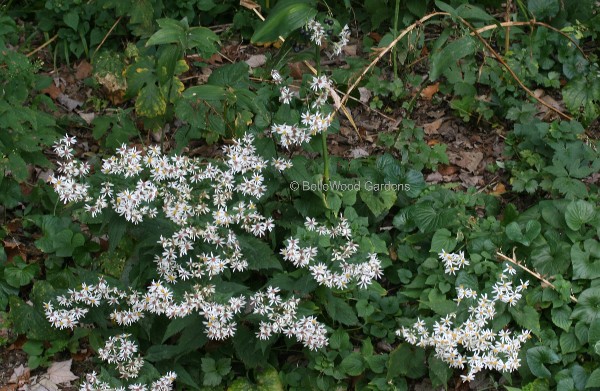
Aster divaricatus, white woods aster. Above, coming into flower.
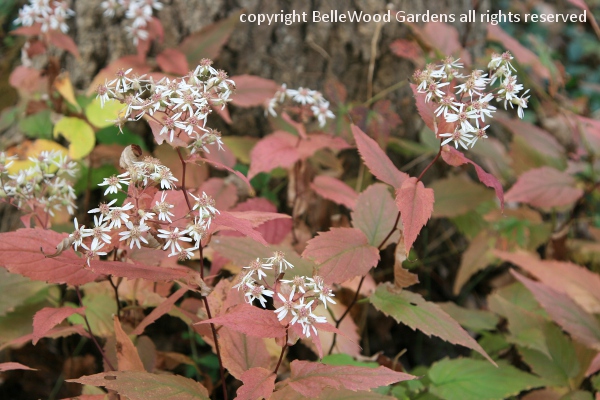
Here, showing rosy autumn coloration of foliage and
the crushed raspberry pink centers of pollinated flowers.
In the winter, the dried seed pods of the flowering plants and the various grasses provide more subdued beauty and textural effect, while providing important winter habitat for a variety of native insects and animals.
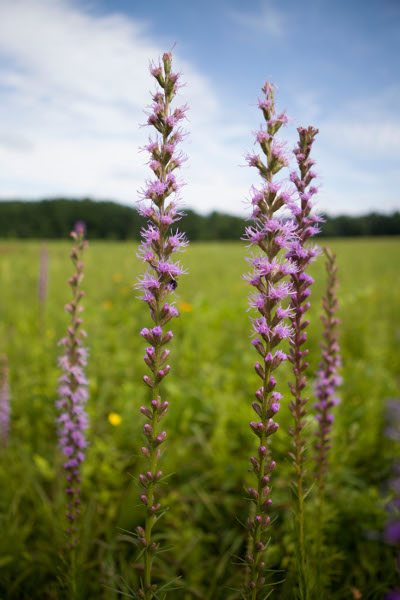
image courtesy Longwood Gardens
Gayfeather, Liatris spicata, above, in bloom. Below, gone to seed.
Goldfinches devour the seeds, even in preference to nyger.
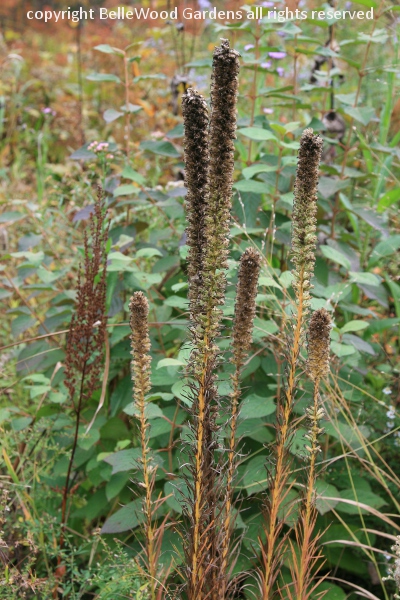
Ecologists speak about the carrying capacity of the land. What does it offer in terms of food and shelter. When pollinators come for nectar, birds may also feed on the insects. The chemicals in milkweed sap make monarchs - from caterpillars feeding on the leaves through to pupated adult butterflies - unpalatable to birds. A bluejay that eats a monarch will become so nauseated it vomits. And never eats another. Viceroy butterflies do not feed on milkweeds but mimic the appearance of the monarch butterfly, thus gaining protection.
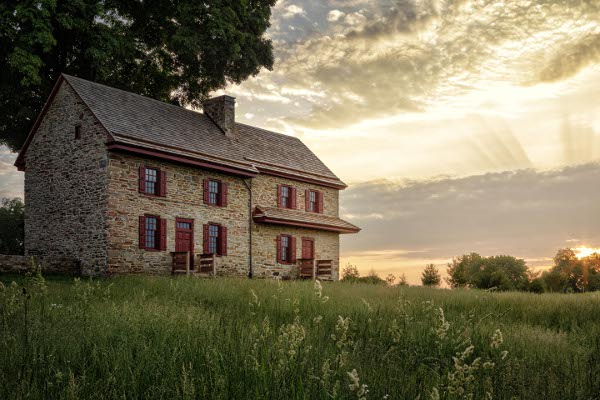
image courtesy Longwood Gardens
Built of native stone in the early 18th century by William Webb, the Webb Farmhouse is very much a destination for your meadow experience. Recently restored, today it contains two interpretive galleries, one with the marvellous hearth that once served as the heart of the family home.
There is so much to enjoy with a visit to the Meadow Garden. It is a comfortable exploration of the natural landscape in contrast to the highly structured more formal gardens found elsewhere on the grounds. Stroll, and enjoy the quiet and serenity. Bird watch.Come again, and see the changes of the natural world. No cars, no buildings, no blaring noises. Shut off your cell phone. Immerse yourself in the slower rhythms of the turning earth. Open every day. Take it easy. Make it simple, even if only for an hour or so. Some tips for your visit. Come. Come again. Morning, midday, dusk. Sunshine or showers. Enjoy.
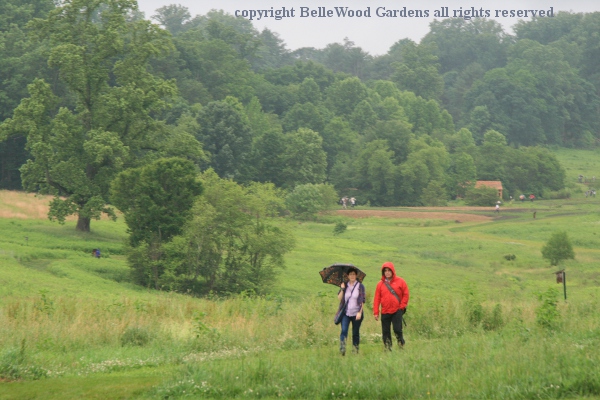
Back to Top
Back to June 2014